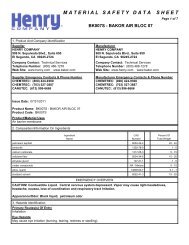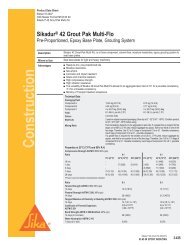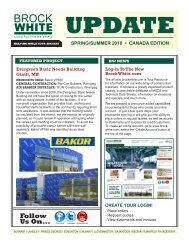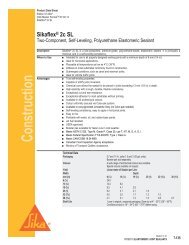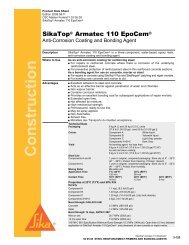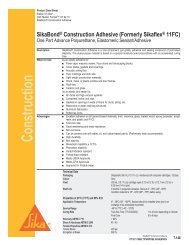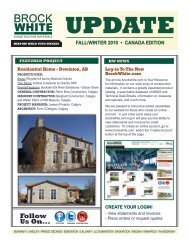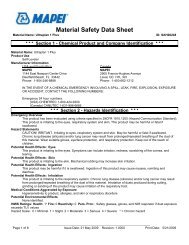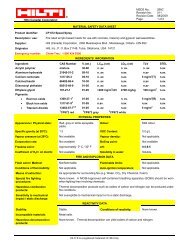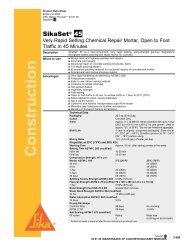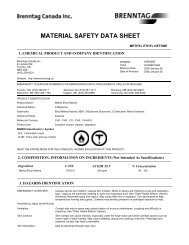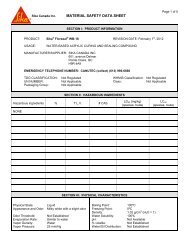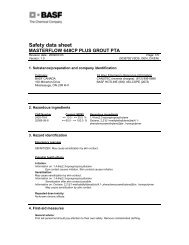GE 1201 Silicone MSDS - Transparent - Brock White
GE 1201 Silicone MSDS - Transparent - Brock White
GE 1201 Silicone MSDS - Transparent - Brock White
Create successful ePaper yourself
Turn your PDF publications into a flip-book with our unique Google optimized e-Paper software.
Material Safety Data Sheet<br />
SCS<strong>1201</strong><br />
<strong>Silicone</strong> sealant (adhesive)<br />
Version: 1.1<br />
04/08/2011<br />
1. CHEMICAL PRODUCT AND COMPANY IDENTIFICATION<br />
Manufactured By: Momentive performance material<br />
260 Hudson River Rd<br />
Waterford NY 12188<br />
Revised: 04/08/2011<br />
Preparer:<br />
PRODUCT STEWARDSHIP COMPLIANCE AND STANDARDS<br />
CHEMTREC 1-800-424-9300<br />
<strong>MSDS</strong> Contact<br />
Information<br />
304-652-8334<br />
Regulatory.Questions@momentive.com<br />
Chemical Family/Use:<br />
Formula:<br />
Sealant<br />
Mixture<strong>Silicone</strong> sealant<br />
HMIS<br />
Flammability: 1 Reactivity: 0 Health: 2<br />
NFPA<br />
Flammability: 1 Reactivity: 0 Health: 2<br />
2. HAZARDS IDENTIFICATION<br />
WHMIS HAZARD CLASS<br />
Very Toxic Material Causing Other Toxic Effects<br />
Toxic Material Causing Other Toxic Effects<br />
EMER<strong>GE</strong>NCY OVERVIEW<br />
WARNING! Irritating to eyes, respiratory system and skin. May be harmful if swallowed. Adverse liver and<br />
reproductive effects reported in animals.<br />
Form: Solid Color: Colorless Odor: Acetic acid.<br />
POTENTIAL HEALTH EFFECTS<br />
IN<strong>GE</strong>STION<br />
May be harmful if swallowed.<br />
SKIN<br />
May cause mild skin irritation.<br />
INHALATION<br />
None known.<br />
EYES<br />
May cause eye irritation.<br />
Page 1/9
Material Safety Data Sheet<br />
SCS<strong>1201</strong><br />
<strong>Silicone</strong> sealant (adhesive)<br />
Version: 1.1<br />
04/08/2011<br />
MEDICAL CONDITIONS AGGRAVATED<br />
None known.<br />
SUBCHRONIC (TAR<strong>GE</strong>T ORGAN )<br />
Liver injury.; Reproductive hazard.<br />
CHRONIC EFFECTS / CARCINO<strong>GE</strong>NICITY<br />
This product or one of its ingredients present at 0.1% or more is NOT listed as a carcinogen or<br />
suspected carcinogen by NTP, IARC, or OSHA.<br />
ROUTES OF EXPOSURE<br />
Dermal; Eye<br />
3. COMPOSITION/INFORMATION ON INGREDIENTS<br />
HAZARDOUS COMPONENTS<br />
PRODUCT COMPOSITION CAS REG NO. WGT. %<br />
Octamethylcyclotetrasiloxane 556-67-2 1 - 5 %<br />
Methyltriacetoxysilane 4253-34-3 1 - 5 %<br />
Note(s): See Section 15 for HMIRC information.<br />
4. FIRST AID MEASURES<br />
IN<strong>GE</strong>STION<br />
DO NOT induce vomiting. Get medical attention immediately.<br />
SKIN<br />
None<br />
INHALATION<br />
If inhaled, remove to fresh air. If not breathing give artificial respiration using a barrier device. If<br />
breathing is difficult give oxygen. Get medical attention.<br />
EYES<br />
In case of contact with eyes, rinse immediately with plenty of water and seek medical advice.<br />
NOTE TO PHYSICIAN<br />
None known.<br />
Page 2/9
Material Safety Data Sheet<br />
SCS<strong>1201</strong><br />
<strong>Silicone</strong> sealant (adhesive)<br />
Version: 1.1<br />
04/08/2011<br />
5. FIRE-FIGHTING MEASURES<br />
FLASH POINT: > 93.3 °C; 200 °F<br />
METHOD:<br />
Estimated<br />
IGNITION TEMPERATURE:<br />
Not applicable<br />
AUTOIGNITION TEMPERATURE:<br />
None<br />
FLAMMABLE LIMITS IN AIR - LOWER (%): Not applicable<br />
FLAMMABLE LIMITS IN AIR - UPPER (%):<br />
Not applicable<br />
SENSITIVITY TO MECHANICAL IMPACT:<br />
No<br />
SENSITIVITY TO STATIC DISCHAR<strong>GE</strong><br />
Sensitivity to static discharge is not expected.<br />
EXTINGUISHING MEDIA<br />
All standard extinguishing agents are suitable.<br />
SPECIAL FIRE FIGHTING PROCEDURES<br />
Firefighters must wear NIOSH/MSHA approved positive pressure self-contained breathing<br />
apparatus with full face mask and full protective clothing.<br />
6. ACCIDENTAL RELEASE MEASURES<br />
ACTION TO BE TAKEN IF MATERIAL IS RELEASED OR SPILLED<br />
Wipe, scrape or soak up in an inert material and put in a container for disposal. Wash walking surfaces<br />
with detergent and water to reduce slipping hazard. Wear proper protective equipment as specified in<br />
the protective equipment section.<br />
7. HANDLING AND STORA<strong>GE</strong><br />
PRECAUTIONS TO BE TAKEN IN HANDLING AND STORA<strong>GE</strong><br />
Avoid contact with eyes, skin, and clothing. Wash hands before eating, drinking, or smoking. Use only in<br />
well-ventilated areas. Remove contact lenses before using sealant. Do not handle lenses until all<br />
sealant has been cleaned from the finger and hands. Residual sealant may remain on fingers for<br />
several days and transfer to lenses, resulting in eye irritation.<br />
Store away from heat, sources of ignition, and incompatibles. Keep out of reach of children. Keep<br />
container closed.<br />
STORA<strong>GE</strong><br />
Keep container tightly closed in a cool, well-ventilated place.<br />
Page 3/9
Material Safety Data Sheet<br />
SCS<strong>1201</strong><br />
<strong>Silicone</strong> sealant (adhesive)<br />
Version: 1.1<br />
04/08/2011<br />
8. EXPOSURE CONTROLS/PERSONAL PROTECTION<br />
ENGINEERING CONTROLS<br />
Eye wash facilities and emergency shower must be available when handling this product.; Showers;<br />
Exhaust ventilation<br />
RESPIRATORY PROTECTION<br />
If exposure limits are exceeded or respiratory irritation is experienced, NIOSH/MSHA approved<br />
respiratory protection should be worn. Supplied air respirators may be required for non-routine or<br />
emergency situations. Respiratory protection must be provided in accordance with OSHA regulations<br />
(see 29CFR 1910.134).<br />
PROTECTIVE GLOVES<br />
Butyl rubber gloves are recommended.<br />
EYE AND FACE PROTECTION<br />
Monogoggles; Face shield<br />
OTHER PROTECTIVE EQUIPMENT<br />
Wear suitable protective clothing and eye/face protection.<br />
Exposure Guidelines<br />
Component CAS RN Source Value<br />
Consult local authorities for acceptable provincial values.<br />
Absence of values indicates none found<br />
PEL - OSHA Permissible Exposure Limit; TLV - ACGIH Threshold Limit Value; TWA - Time Weighted Average<br />
OSHA revoked the Final Rule Limits of January 19, 1989 in response to the 11th Circuit Court of Appeals decision (AFL-CIO v. OSHA)<br />
effective June 30, 1993. See 29 CFR 1910.1000 (58 FR 35338).<br />
9. PHYSICAL AND CHEMICAL PROPERTIES<br />
BOILING POINT - C & F:<br />
No data available.<br />
VAPOR PRESSURE (20 C) (MM HG):<br />
No data available.<br />
VAPOR DENSITY (AIR=1):<br />
Not applicable<br />
FREEZING POINT:<br />
No data available.<br />
MELTING POINT:<br />
No data available.<br />
PHYSICAL STATE:<br />
Solid<br />
ODOR:<br />
Acetic acid.<br />
ODOR THRESHOLD:<br />
No data available.<br />
COLOR:<br />
Colorless<br />
EVAPORATION RATE (BUTYL ACETATE=1): < 1<br />
SPECIFIC GRAVITY (WATER=1): ca. 1.06<br />
DENSITY:<br />
ca. 1.06 g/cm3<br />
ACID / ALKALINITY (MEQ/G):<br />
Not applicable<br />
Page 4/9
Material Safety Data Sheet<br />
SCS<strong>1201</strong><br />
<strong>Silicone</strong> sealant (adhesive)<br />
Version: 1.1<br />
04/08/2011<br />
pH:<br />
VOLATILE ORGANIC CONTENT:<br />
SOLUBILITY IN WATER (20 C):<br />
SOLUBILITY IN ORGANIC SOLVENT (STATE<br />
SOLVENT):<br />
PARTITION COEFFICIENT: N-OCTANOL/WATER:<br />
Not applicable<br />
No data available.<br />
No data available.<br />
Toluene<br />
No data available.<br />
10. STABILITY AND REACTIVITY<br />
STABILITY<br />
Stable<br />
HAZARDOUS POLYMERIZATION<br />
Hazardous polymerisation does not occur.<br />
HAZARDOUS THERMAL DECOMPOSITION / COMBUSTION PRODUCTS<br />
Carbon dioxide; Acetic acid.; Silicon dioxide.; Formaldehyde.; This product contains<br />
methylpolysiloxanes which can generate formaldehyde at approximately 300 degrees Fahrenheit<br />
(150'C) and above, in atmospheres which contain oxygen. Formaldehyde is a skin and respiratory<br />
sensitizer, eye and throat irritant, acute toxicant, and potential cancer hazard. A <strong>MSDS</strong> for<br />
formaldehyde is available from Momentive.<br />
INCOMPATIBILITY (MATERIALS TO AVOID)<br />
None known.<br />
CONDITIONS TO AVOID<br />
None known.<br />
11. TOXICOLOGICAL INFORMATION<br />
ACUTE ORAL<br />
Remarks: No data available.<br />
Repeated dose toxicity<br />
None<br />
ACUTE DERMAL<br />
Remarks: No data available.<br />
ACUTE INHALATION<br />
Remarks: No data available.<br />
OTHER<br />
Octamethylcyclotetrasiloxane<br />
Ingestion: Rodents given large doses via oral gavage of octamethylcyclotetrasiloxane (1600 mg/kg day,<br />
14 days) developed increased liver weights relative to unexposed control animals due to hepatocellular<br />
hyperplasia (increased number of liver cells which appear normal) as well as hypertrophy (increased cell<br />
Page 5/9
Material Safety Data Sheet<br />
SCS<strong>1201</strong><br />
<strong>Silicone</strong> sealant (adhesive)<br />
Version: 1.1<br />
04/08/2011<br />
size).<br />
Inhalation: In inhalation studies, laboratory rodents exposed to octamethylcyclotetrasiloxane (300 ppm<br />
five days week, 90 days)developed increased liver weights in female animals relative to unexposed<br />
control animals. When the exposure was stopped, liverweights returned to normal. Microscopic<br />
examination of the liver cells did not show any evidence of pathology. Inhalationstudies utililizing<br />
laboratory rabbits and guinea pigs showed no effects on liver weights. Inhalation exposures typical<br />
ofindustrial usage (5-10 ppm) showed no toxic effects in rodents.<br />
Range finding reproductive studies were conducted (whole body inhalation, 70 days prior to mating,<br />
through mating, gestationand lactation) with octamethylcyclotetrasiloxane (D4). Rats were exposed to<br />
70 and 700 ppm. In the 700 ppm group, there wasa statistically significant reduction in mean litter size<br />
and in implantation sites. No D4 related clinical signs were observedin the pups and no exposure<br />
related pathological findings were found.<br />
Interim results from a two generation reproductive study in rats exposed to 500 and 700 ppm D4 (whole<br />
body inhalation, 70 daysprior to mating, through mating, gestation and lactation) resulted in a statistically<br />
significant decrease in live meanlitter size as well as extended periods of off-spring delivery (dystocia).<br />
These results were not observed at the 70 and 300ppm dosing levels.<br />
Preliminary results from an ongoing 24-month combined chronic/oncogenicity study in rats exposed to<br />
10, 30, 150, or700 ppm D4 showed test-article related effects in the kidney (male and female) and uterus<br />
of rats exposed for 12 to 24 months. These effects include increased kidney weight and severity of<br />
chronic nephropathy, increased uterine weight,increased incidence of endometrial cell hyperplasia, and<br />
an increased incidence of endometrial adenomas. All of theseeffects are limited to the 700 ppm<br />
exposure group.<br />
These results have been shown to be rat-specific. Further studies are ongoing.<br />
In developmental toxicity studies, rats and rabbits were exposed to octamethylcyclotetrasiloxane at<br />
concentrations up to 700 ppmand 500 ppm respectively. No teratogenic effects (birth defects) were<br />
observed in either study.<br />
<strong>GE</strong>NETIC TOXICITY IN VITRO<br />
None<br />
<strong>GE</strong>NETIC TOXICITY IN VIVO<br />
None<br />
SENSITIZATION<br />
No data available.<br />
SKIN IRRITATION<br />
No data available.<br />
EYE IRRITATION<br />
No data available.<br />
Page 6/9
Material Safety Data Sheet<br />
SCS<strong>1201</strong><br />
<strong>Silicone</strong> sealant (adhesive)<br />
Version: 1.1<br />
04/08/2011<br />
MUTA<strong>GE</strong>NICITY<br />
No data available.<br />
OTHER EFFECTS OF OVEREXPOSURE<br />
This product contains methylpolysiloxanes which can generate formaldehyde at approximately 300<br />
degrees Fahrenheit (150'C) and above, in atmospheres which contain oxygen. Formaldehyde is a skin<br />
and respiratory sensitizer, eye and throat irritant, acute toxicant, and potential cancer hazard. A <strong>MSDS</strong><br />
for formaldehyde is available from Momentive., Acetic acid released during curing., Contains<br />
octamethylcyclotetrasiloxane which may cause reproductive effects based on animal data.<br />
12. ECOLOGICAL INFORMATION<br />
ECOTOXICITY<br />
Ecotoxicological data for this product is not available.<br />
DISTRIBUTION<br />
No data available.<br />
CHEMICAL FATE<br />
No data available.<br />
13. DISPOSAL CONSIDERATIONS<br />
DISPOSAL METHOD<br />
Disposal should be made in accordance with federal, state and local regulations.<br />
14. TRANSPORT INFORMATION<br />
Further Information:<br />
This product is not regarded as dangerous goods according to the national<br />
and international regulations on the transport of dangerous goods.<br />
15. REGULATORY INFORMATION<br />
Inventories<br />
Australia Inventory of Chemical<br />
Substances (AICS)<br />
EU list of existing chemical<br />
substances<br />
Japan Inventory of Existing & New<br />
y (positive listing)<br />
y (positive listing)<br />
y (positive listing)<br />
Page 7/9
Material Safety Data Sheet<br />
SCS<strong>1201</strong><br />
<strong>Silicone</strong> sealant (adhesive)<br />
Version: 1.1<br />
04/08/2011<br />
Chemical Substances (ENCS)<br />
China Inventory of Existing<br />
Chemical Substances<br />
Korea Existing Chemicals<br />
Inventory (KECI)<br />
Canada DSL Inventory<br />
Canada NDSL Inventory<br />
Philippines Inventory of Chemicals<br />
and Chemical Substances<br />
(PICCS)<br />
y (positive listing)<br />
y (positive listing)<br />
y (positive listing)<br />
n (Negative listing)<br />
y (positive listing)<br />
TSCA list y (positive listing) On TSCA Inventory<br />
For inventories that are marked as quantity restricted or special cases, please contact Momentive.<br />
Canadian Regulatory Information<br />
WHMIS HAZARD CLASS<br />
Very Toxic Material Causing Other Toxic Effects, Toxic Material Causing Other Toxic Effects<br />
CPR Compliance<br />
This product has been classified according to the hazard criteria of the CPR and the <strong>MSDS</strong> contains all of the<br />
information required by the CPR.<br />
US Regulatory Information<br />
SARA (311,312) HAZARD CLASS<br />
Acute Health Hazard<br />
16. OTHER INFORMATION<br />
OTHER<br />
These data are offered in good faith as typical values and not as product specifications. No warranty,<br />
either expressed or implied, is made. The recommended industrial hygiene and safe handling<br />
procedures are believed to be generally applicable. However, each user should review these<br />
recommendations in the specific context of the intended use and determine whether they are<br />
appropriate.<br />
,C = ceiling limit NEGL = negligible<br />
EST = estimated NF = none found<br />
NA = not applicable UNKN = unknown<br />
NE = none established REC = recommended<br />
ND = none determined V = recommended by vendor<br />
SKN = skin<br />
TS = trade secret<br />
R = recommended MST = mist<br />
NT = not tested STEL = short term exposure limit<br />
ppm = parts per million ppb = parts per billion<br />
By-product= reaction by-product, TSCA inventory status not required under 40 CFR part 720.30(h-2).<br />
Page 8/9
Material Safety Data Sheet<br />
SCS<strong>1201</strong><br />
<strong>Silicone</strong> sealant (adhesive)<br />
Version: 1.1<br />
04/08/2011<br />
Page 9/9


